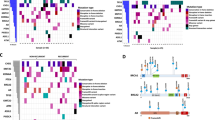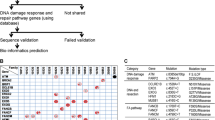Abstract
Penile cancer is a rare neoplasm that seems to be linked to socio-economic differences. Mitochondrial genome alterations are common in many tumors types and are reported as regulating oxidative metabolism and impacting tumorigenesis. In this study, we evaluate for the first time the mitochondrial genome in penile carcinoma (PeCa), aiming to evaluate heteroplasmy, mitochondrial DNA (mtDNA) mutational load and mtDNA content in Penile tumors. Using next generation sequencing (NGS), we sequenced the mitochondrial genome of 13 penile tumors and 12 non-neoplastic tissue samples, which allowed us to identify mtDNA variants and heteroplasmy. We further evaluated variant’s pathogenicity using Mutpred predictive software and calculated mtDNA content using quantitative PCR. Mitochondrial genome sequencing revealed an increase number of non-synonymous variants in the tumor tissue, along with higher frequency of heteroplasmy and mtDNA depletion in penile tumors, suggesting an increased mitochondrial instability in penile tumors. We also described a list of mitochondrial variants found in penile tumor and normal tissue, including five novel variants found in the tumoral tissue. Our results showed an increased mitochondrial genome instability in penile tumors. We also suggest that mitochondrial DNA copy number (mtDNAcn) and mtDNA variants may act together to imbalance mitochondrial function in PeCa. The better understanding of mitochondrial biology can bring new insights on mechanisms and open a new field for therapy in PeCa.



Similar content being viewed by others
References
Bleeker MCG, Heideman DAM, Snijders PJF et al (2008) Penile cancer: epidemiology, pathogenesis and prevention. World J Urol 27:141–150. https://doi.org/10.1007/s00345-008-0302-z
Society AC (2016) Cancer facts & figs. In: https://www.cancer.orgcancersmall-cell-lung-cancerdetection-diagnosis-stagingsurvival-rates.html
INCA (2017) Estimativas de Câncer 2016. In: http://www.inca.gov.brestimativaindex.aspID. Accessed 6 Jun 2017
Daling JR, Madeleine MM, Johnson LG et al (2005) Penile cancer: importance of circumcision, human papillomavirus and smoking in in situ and invasive disease. Int J Cancer 116:606–616. https://doi.org/10.1002/ijc.21009
Dillner J, Krogh von G, Horenblas S, Meijer CJLM. (2009) Etiology of squamous cell carcinoma of the penis. Scand J Urol Nephrol 34:189–193. https://doi.org/10.1080/00365590050509913
Ali SM, Pal SK, Wang K et al (2016) Comprehensive genomic profiling of advanced penile carcinoma suggests a high frequency of clinically relevant genomic alterations. Oncologist 21:33–39. https://doi.org/10.1634/theoncologist.2015-0241
Kuasne H, de Syllos Cólus IM, Busso AF et al (2015) Genome-wide methylation and transcriptome analysis in penile carcinoma: uncovering new molecular markers. Clin Epigenetics 7(1):46. https://doi.org/10.1186/s13148-015-0082-4
Kuasne H, Barros-Filho MC, Busso-Lopes A et al (2017) Integrative miRNA and mRNA analysis in penile carcinomas reveals markers and pathways with potential clinical impact. Oncotarget 8:15294–15306. https://doi.org/10.18632/oncotarget.14783
Reznik E, Miller ML, Şenbabaoğlu Y et al (2016) Mitochondrial DNA copy number variation across human cancers. eLife 5:e10769. https://doi.org/10.7554/eLife.10769
Yu M (2011) Generation, function and diagnostic value of mitochondrial DNA copy number alterations in human cancers. Life Sci 89:65–71
Ghelli A, Tropeano CV, Calvaruso MA et al (2013) The cytochrome b p. 278Y> C mutation causative of a multisystem disorder enhances superoxide production and alters supramolecular interactions of respiratory chain complexes. Hum Mol Genet 22:2141–2151. https://doi.org/10.1093/hmg/ddt067
Hardie R-A, van Dam E, Cowley M et al (2017) Mitochondrial mutations and metabolic adaptation in pancreatic cancer. Cancer Metab 5(1):2. https://doi.org/10.1186/s40170-017-0164-1
Iommarini L, Calvaruso MA, Kurelac I et al (2013) Complex I impairment in mitochondrial diseases and cancer: parallel roads leading to different outcomes. Int J Biochem Cell Biol 45:47–63. https://doi.org/10.1016/j.biocel.2012.05.016
Ishikawa K, Takenaga K, Akimoto M et al (2008) ROS-generating mitochondrial DNA mutations can regulate tumor cell metastasis. Science 320:661–664. https://doi.org/10.1126/science.1156906
de Araujo LF, Fonseca AS, Muys BR et al (2015) Mitochondrial genome instability in colorectal adenoma and adenocarcinoma. Tumour Biol 36:8869–8879. https://doi.org/10.1007/s13277-015-3640-7
Pejaver V, Urresti J, Lugo-Martinez J et al (2017) MutPred2: inferring the molecular and phenotypic impact of amino acid variants. bioRxiv. https://doi.org/10.1101/134981
Lott MT, Leipzig JN, Derbeneva O et al (2013) mtDNA variation and analysis using MITOMAP and MITOMASTER. Curr Protoc Bioinform 44:1–23. https://doi.org/10.1002/0471250953.bi0123s44
Venegas V, Wang J, Dimmock D, Wong LJ (2011) Real-time quantitative PCR analysis of mitochondrial DNA content. 72:101–119. https://doi.org/10.1002/0471142905.hg1907s68
Ju YS, Alexandrov LB, Gerstung M et al (2014) Origins and functional consequences of somatic mitochondrial DNA mutations in human cancer. eLife 3:415–454. https://doi.org/10.7554/eLife.02935
Mullen AR, Hu Z, Shi X et al (2014) Oxidation of alpha-ketoglutarate is required for reductive carboxylation in cancer cells with mitochondrial defects. Cell Rep 7:1679–1690. https://doi.org/10.1016/j.celrep.2014.04.037
Singh RK, Srivastava A, Kalaiarasan P et al (2014) mtDNA germ line variation mediated ROS generates retrograde signaling and induces pro-cancerous metabolic features. Sci Rep 4:6571. https://doi.org/10.1038/srep06571
Ji Y, Liang M, Zhang J et al (2016) Mitochondrial ND1 variants in 1281 Chinese subjects with Leber’s hereditary optic neuropathy. Invest Ophthalmol Vis Sci 57:2377–2389. https://doi.org/10.1167/iovs.16-19243
Sciacco M, Prelle A, Fagiolari G et al (2005) A case of CPT deficiency, homoplasmic mtDNA mutation and ragged red fibers at muscle biopsy. J Neurol Sci 239:21–24. https://doi.org/10.1016/j.jns.2005.07.008
Gerbitz KD, van den Ouweland JM, Maassen JA, Jaksch M (1995) Mitochondrial diabetes mellitus: a review. Biochim Biophys Acta 1271:253–260
Jerónimo C, Nomoto S, Caballero OL et al (2001) Mitochondrial mutations in early stage prostate cancer and bodily fluids. Oncogene 20:5195–5198. https://doi.org/10.1038/sj.onc.1204646
Zhang J, Zhou X, Zhou J et al (2010) Mitochondrial ND6 T14502C variant may modulate the phenotypic expression of LHON-associated G11778A mutation in four Chinese families. Biochem Biophys Res Commun 399:647–653. https://doi.org/10.1016/j.bbrc.2010.07.135
Abu-Amero KK, Bosley TM (2006) Mitochondrial abnormalities in patients with LHON-like optic neuropathies. Invest Ophthalmol Vis Sci 47:4211–4220. https://doi.org/10.1167/iovs.06-0295
Ye K, Lu J, Ma F et al (2014) Extensive pathogenicity of mitochondrial heteroplasmy in healthy human individuals. Proc Natl Acad Sci USA 111:10654–10659. https://doi.org/10.1073/pnas.1403521111
Stefano G, Kream R (2016) Mitochondrial DNA heteroplasmy in human health and disease. Biom Rep. https://doi.org/10.3892/br.2016.590
Zhang G, Frederick DT, Wu L et al (2016) Targeting mitochondrial biogenesis to overcome drug resistance to MAPK inhibitors. J Clin Invest 126:1834–1856. https://doi.org/10.1172/JCI82661
Acknowledgements
We would like to thank Anemari Dinarti-Santos for technical support.
Funding
This study was funded by São Paulo Research Foundation (FAPESP), Grants #2009/53853-5, #2013/25119-0, and #2013/08135-2; and by Research Support of the University Sao Paulo, CISBi-NAP/USP Grant #12.1.25441.01.2.
Author information
Authors and Affiliations
Corresponding author
Ethics declarations
Conflict of interest
The authors declare that there is no conflict of interest in the authorship or publication of contribution.
Ethical approval
This study was previously approved by the Ethics Committee of Ribeirão Preto at University of São Paulo (Process Number 14096/2010). All patients gave their written consent to participate in this study.
Electronic supplementary material
Below is the link to the electronic supplementary material.
Rights and permissions
About this article
Cite this article
Araujo, L.F., Terra, A.T., Sares, C.T.G. et al. Mitochondrial genome analysis in penile carcinoma. Mol Biol Rep 45, 591–600 (2018). https://doi.org/10.1007/s11033-018-4197-5
Received:
Accepted:
Published:
Issue Date:
DOI: https://doi.org/10.1007/s11033-018-4197-5




